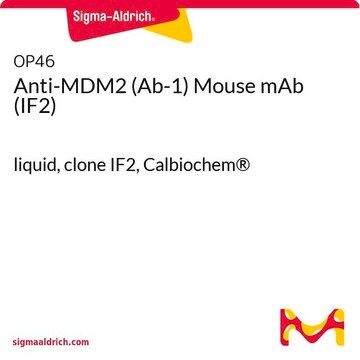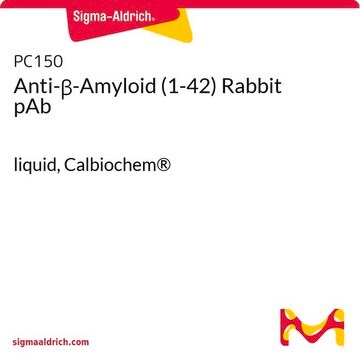OP145
Anti-MDM2 (Ab-5) Mouse mAb (4B2C1.11)
liquid, clone 4B2C1.11, Calbiochem®
Sinonimo/i:
Anti-Ubiquitin Protein Ligase, Anti-p53 Binding Protein, Ant-Murine Double Minute Chromosome-2
About This Item
Prodotti consigliati
Origine biologica
mouse
Livello qualitativo
Forma dell’anticorpo
purified antibody
Tipo di anticorpo
primary antibodies
Clone
4B2C1.11, monoclonal
Forma fisica
liquid
non contiene
preservative
Reattività contro le specie
human
Produttore/marchio commerciale
Calbiochem®
Condizioni di stoccaggio
OK to freeze
avoid repeated freeze/thaw cycles
Isotipo
IgG1
Condizioni di spedizione
wet ice
Temperatura di conservazione
−20°C
modifica post-traduzionali bersaglio
unmodified
Informazioni sul gene
human ... MDM2(4193)
Descrizione generale
Immunogeno
Applicazioni

Immunoblotting (2 g/ml, chemiluminescence)
Immunofluorescence (2.5 g/ml)
Immunoprecipitation (1 g/reaction, see application references)
Paraffin Sections (2.5 g/ml, heat pre-treatment required)
Confezionamento
Attenzione
Stato fisico
Ricostituzione
Risultati analitici
A549 or MCF7 cells or breast carcinoma tissue
Altre note
Barak, Y., et al. 1993. EMBO. J.12, 461.
Ladanyi, M., et al. 1993. Cancer Res.53, 16.
Leach, F.S., et al. 1993. Cancer Res.53, 2231.
Oliner, J.D., et al. 1993. Nature362, 857.
Momand, J., et al. 1992. Cell69, 1237.
Oliner, J.D., et al. 1992. Nature358, 80.
Fakharzadeh, S.S., et al. 1991. EMBO J.10, 1565.
Note legali
Not finding the right product?
Try our Motore di ricerca dei prodotti.
Codice della classe di stoccaggio
10 - Combustible liquids
Classe di pericolosità dell'acqua (WGK)
WGK 3
Certificati d'analisi (COA)
Cerca il Certificati d'analisi (COA) digitando il numero di lotto/batch corrispondente. I numeri di lotto o di batch sono stampati sull'etichetta dei prodotti dopo la parola ‘Lotto’ o ‘Batch’.
Possiedi già questo prodotto?
I documenti relativi ai prodotti acquistati recentemente sono disponibili nell’Archivio dei documenti.
Il team dei nostri ricercatori vanta grande esperienza in tutte le aree della ricerca quali Life Science, scienza dei materiali, sintesi chimica, cromatografia, discipline analitiche, ecc..
Contatta l'Assistenza Tecnica.








